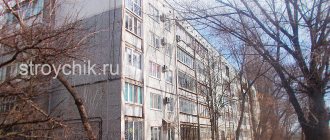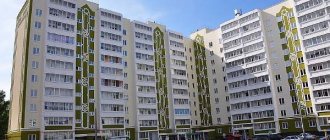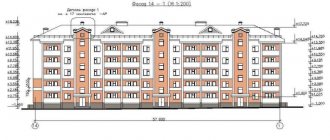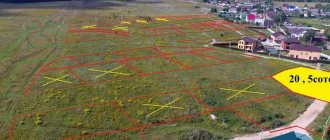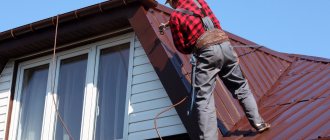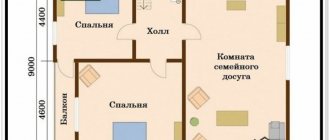The height of a 5-storey building is how much in meters
If we take the most popular and standard answer, we get -15 meters. But experts know that the height of five floors can be 14 meters and even more than 20 meters. It all depends on the typical house design. It must be said that quite recently, houses 15 meters high were the most popular standard house designs. Low buildings in which you can do without an elevator and fire safety devices.
Typical "Khrushchev".
These were Soviet standard panel or brick residential buildings, usually 5-story, with small-sized apartments, the well-known “Khrushchev” buildings.
Number of floors [ edit | edit code]
Buildings are often classified by the number of floors.
Number of storeys - the number of above-ground floors, including the technical floor, attic, as well as the basement floor, if the top of its ceiling is at least 2 m above the average planning level of the ground. Number of floors - all floors, including underground, basement, basement, above-ground , technical, attic and others. The term “number of floors” is enshrined in the Town Planning Code as a criterion for the need to conduct a state examination of design documentation and cannot be replaced by the term “number of floors.” It is important to note that this clarification is effective only in determining the need for a state examination of the project. In a number of cases, the concept of “number of storeys” is used to clarify the possibility of changing the characteristics of buildings located in the “historical development zone” during reconstruction and restoration
Namely, add-ons or additions to part of a building.
There are low-rise, mid-rise and multi-storey buildings, the tallest are skyscrapers with up to a hundred floors. [ source not specified 2736 days
] High-rise buildings usually have additional safety systems, for example, fire extinguishing systems and smoke-free stairwells, the presence of which is regulated by building regulations (in Russia these are SNiPs).
Characteristics of brick, large-block and panel “Khrushchev” buildings
Khrushchev buildings were built according to standard designs in the style of functionalism. Nothing extra. They were panel, brick, and less often large-block. As a result, the most famous were the Khrushchev panel buildings. Because they were quickly built from pre-prepared reinforced concrete panels.
The speed of construction of “Khrushchev” buildings was very high, so the quality of the houses often suffered because of this. In addition, these houses had low thermal insulation of external walls and poor sound insulation inside the house.
Typically, the height of most “Khrushchev” buildings was 4 or 5 floors. Because the height of a five-story building is the maximum height where building codes do not require an elevator. As a result, the 5-story format replaced the 4-story format due to the opportunity to build more apartments.
“Khrushchev buildings” could have 2 or 3 floors. These were more common in rural areas or small towns. Some series of Khrushchev buildings even had a garbage chute. Of course, the height of the house directly depended on the height of the ceiling.
Large block "Khrushchev".
History of the construction of Burj Khalifa
The construction of the Burj Khalifa cost one and a half billion dollars, and the author of the project was the architect Adrian Smith. This architect designed the Jin Mao skyscraper in China, 420 meters high. Interestingly, the contractor for the construction of Burj Khalifa was a division of Samsung. The same division was involved in the construction of the Petronas Towers in Kuala Lumpur, Malaysia.
Beautiful Petronas Towers in Malaysia. This is one of the most elegant buildings. Largely due to the connecting bridge.
Interestingly, during the construction of the Burj Khalifa, the final height of the tower was kept secret. In general, there are many secrets in the world, but in this case it was done so that if someone decides to build a building higher, the project could be changed and still be higher.
The foundation of the building was laid in 2004, and construction itself proceeded at a rate of 1-2 floors per week. 12,000 workers from different countries were engaged in construction every day. In total, the construction required more than 300,000 cubic meters of concrete and 60,000 tons of steel reinforcement.
Starting in 2007, the tower began to surpass previous height record holders until it became the tallest. It finally reached its height of 818 meters in early 2009, a little less than a year before the official opening.
Height of a 5 storey building
For example, in a Khrushchev building where the ceilings are 2.40, the height of a 3-story building will be approximately 9 meters. The height of the 5-storey building is 15 meters in height.
Apartments in Khrushchev's houses were mostly one- and two-room. There were fewer three-room apartments. Four rooms is very rare.
- The ceiling height in Khrushchev-era buildings is from 2.45 to 2.6 meters.
- In some series of block houses it is 2.7 m.
- Kitchen area - from 4.9 to 7.1 m² (up to 7.5 m² in some apartments of series II-18 houses). Basically the kitchen had an area of 5.5 to 6 m²
- The bathroom, in most cases, is adjacent in all apartments.
- Two- and three-room apartments usually have a walk-through living room.
In addition, the “Khrushchev buildings” were provided with: central heating, cold water supply, sewerage, natural exhaust ventilation, and a kitchen stove. Hot water supply could be either central or individual, using gas water heaters or solid fuel water heaters. With rare exceptions, most apartments had a balcony (except for those located on the first floors); in some typical Khrushchev-era apartments, the end apartments had loggias.
"Khrushchev refrigerator"
Almost everywhere under the Khrushchev kitchen window, where there was very little space, they made a specific built-in closet type closet for storing food. The thickness of the outer wall in this closet was usually half a brick. In another version, a special hole was made to the outside, which served as ventilation. During the cold season, the cabinet replaced the refrigerator.
Under the window is a “Khrushchev refrigerator.”
Pantry
In many Khrushchev-era projects, especially the 1-335, 1-447, 1-464 series, the apartments have fairly large (2–3 m2) dark rooms without windows for storing things (storage rooms). In later designs, the size of closets was significantly reduced, from rooms to built-in wardrobes. In the projects of Brezhnev's houses, due to the proliferation of cabinets and other furniture, storage rooms were gradually abandoned.
Window in the bathroom
Even in the Khrushchev apartments, a window was made between the kitchen and the bathroom. (Sometimes with a separate bathroom - between the bath and toilet). A window about 40 cm high was made under the ceiling. In the kitchen it was opposite the street window. As a result of this solution, it was possible to save on electricity when visiting the bathroom.
Panel Khrushchev buildings were divided into demolishable and non-demolishable. The Khrushchev-era apartment buildings of the demolished series were built to temporarily solve the housing problem and were designed to last 25–30 years. Khrushchev buildings of the unbearable series had a design life of 50-60 years. But as a result of the study, it turned out that the service life can be extended to 150 years (if repaired in time). By the way, brick Khrushchev buildings belong to the unbearable series and have a service life of at least 100-150 years.
It should be noted that the window, about 40 cm high, is located under the ceiling. Moreover, in the kitchen it is located opposite the street window.
Approximate floor height according to SNiP
Apartment buildings include any buildings that have several exits to the building site, or those buildings whose height is more than 3 floors. There is a classification of the number of storeys of buildings, according to the number of floors or the number of meters in height.
This classification includes all modern buildings, except skyscrapers, and by looking into it, you can find out that residential buildings are:
- low-rise (up to 3 floors or up to 12 m: possible non-standard ceiling heights are taken into account);
- mid-rise buildings include floors 3 to 5, standard five-story buildings about 15 meters high;
- from the 6th to the 10th floor are considered high-rise, the approximate height of the maximum building is 30 m;
- all others are considered in categories up to 50, 75 and more meters.
The number of floors does not always mean reaching a certain level. The construction of 6-story buildings in Moscow, where the 1st floor was intended for shops, could be almost as tall as a typical nine-story building. The average height of one floor is considered to be 2.6–2.8 m.
But in typical projects it could be 2.50, 2.64, 2.7 m. In panel houses it depended on the size of the panel, and they were from 2.5 to 2.8 meters. In a brick house, the ceiling height is from 2.8 to 3 m. In a monolithic structure, much depends on the concrete used, but the ceilings usually reach sizes in the range from 3 to 3 m 30 cm.
How to determine the height of a building
Calculate the height of buildings as follows: multiply the height of the ceiling + ceiling by the number of floors. Typically, the average height of one floor is 3 meters. Then, the height of a 9-story building is 27 meters.
Therefore, it is not difficult to calculate how many meters, for example - 15 floors? It turns out that 45 meters.
- The height of a 25-story building is approximately 75 m.
- The height of a 20-story building is 60 m.
- 25 meters, how many floors? We divide 25 ⁄ 3, approximately 8 floors.
- The 16-storey building will be 48 meters high.
- 12-storey building with a height of -36 m.
- How many floors are there in 35 m? The answer is approximately 12 floors. By the way - 35 floors. will be 105 m.
Advantages and disadvantages of standard height
How is the height of a three-story house measured?
The average value when building a private country house is most often optimal. When the goal is to build comfortable housing without extra costs and frills, the best solution is to follow the standards.
Disadvantages of high ceilings
- Building rooms with high ceilings costs much more and requires more material. This is especially true for two-story houses, so the ceilings on the second floor are usually lower than on the first.
- Due to the increase in the volume of the room, the cost of heating also increases.
- Very often this does not make any sense: a few tens of the upper centimeters remain unused, hanging over as unnecessary space.
Disadvantages of low ceilings
- Psychological feeling of tightness and discomfort.
- Difficulty in choosing furniture and fittings. It is necessary to choose furniture in such a way that it does not compress the space and does not cause inconvenience.
Vertical dimension definition
- Foundation + roof. The depth of the foundation is different everywhere. For example - 2.20 m. + 5 m. = 7.5 m. The height of the floor with ceilings is approximately 3 m. Then the height of the five-story building will be 22.5 m.
- If the house has no basement, and the vertical from the ground is 1.5 m. We calculate the height of each floor together with the ceiling - 15 m. We add the roof height (according to the standard 5 m.) We get 21.5 m.
- It would be easier to determine the height of a house if there was a standard vertical floor dimension. But there is no standard. Because there have always been different house designs. Some had a basement and a multi-pitched roof. Others with a semi-basement and attic. Houses were built with a basement and a high ground floor. Houses with a flat roof but with a 2.5m basement were also built.
- Therefore, on average, a really 5-story building is about 15 m long. It all depends on the thickness of the floor and the height of the floor.
- The very first brick houses could be 14 m high. The ceiling height was small - 2.40 m. By the way, in “Stalinist” houses the amount of air per person was taken into account. In the planning of “Khrushchev” buildings, in the early stages, they were not interested in such trifles.
- Soviet-era houses are a thing of the past. Along with them are standard projects with GOST standards, standard blocks and parts. Therefore, it is simply impossible to determine at what height the apartment is located if you do not know the design of the house. Therefore, a five-story building, taking into account the roof, can be from 22-28 m vertically.
The height of a five-story building. A variant of a standard house design with 2 entrances.
Two-story house with an area of 12 by 12
When building a two-story house with the specified area, it is recommended to opt not for brick, but for wood, which is explained by a number of advantages:
- wood absorbs heat well and practically does not give it away, so the building is always warm and heating costs are minimal;
- compared to concrete or brick buildings, the house weighs approximately 3 times less, this will save money during the construction of the foundation;
- wood is capable of transmitting oxygen, so such buildings “breathe”, and this has a beneficial effect on the microclimate in the room and the health of its residents.
How to understand projects
"Stalin", Stalin's houses
All names come from the name of Stalin, during whose reign these houses were built. The main building material for the construction of Stalinist houses is brick. Brick houses were distinguished by higher number of storeys, elegant facades, spacious apartments, and better sound insulation.
These are large, beautiful houses with Soviet attributes. The facade of the house was usually decorated with stucco decoration. The outside of Stalin's houses was covered with plaster; large "nomenklatura" houses could be faced with stone or ceramic tiles. These houses have a high ground floor. The size to the ceiling is at least 3 meters. Hence the calculation of the height of the house. Therefore, the height of a five-story building is at least 20 m.
“Stalin” is the common colloquial name for apartment buildings built in the USSR from the late 1930s to the late 1950s
After Stalin, Khrushchev began to fight against “excesses” and before the start of mass construction of Khrushchev houses, “torn” Stalinist houses were erected without stucco decoration and often without plaster.
"Khrushchevka"
Who doesn't know them! By the way, there are still plenty of them all over the country! Now they are being demolished in big cities. But at one time, the “Khrushchevs” made it possible to resolve the acute housing shortage. At that time, no one was interested in the appearance of housing. Therefore, the apartments were small, the architecture of the houses was extremely simple and functional. They were built quickly, from standard parts, but there were many disadvantages. For example, the ceiling height was 2.48m. Later it was increased to 2.60 or 2.64m.
By the way, low-rise Khrushchev apartment buildings were built not only in villages, but also in small towns. Panel houses were popular. Because they were built quickly.
"Brezhnevki"
The name of a series of houses built in the USSR from the mid-1960s to the end of the 1980s, mainly during the reign of L. I. Brezhnev. The name “improved apartments” is also found. For more spacious houses built in the 1980s - “new layout”.
These are the same “boxes” as “Khrushchev buildings”. But in these houses the ceiling height was 2.7m. There were more spacious stairs and landings. Therefore, the height of the five-story building was completely different. The roof of all Brezhnevkas is flat, covered with bitumen materials, and, unlike Khrushchevkas, is equipped with internal gutters. Low-rise houses for rural and suburban construction can have two- or multi-pitched slate roofs.
Brezhnevkas were built in the USSR from the mid-1960s to the end of the 1980s.
Brezhnev's houses differ from Khrushchev's in the following features:
- Availability of a watch (since 1970), an elevator and a garbage chute; in later Brezhnevkas there is a staircase, etc. “back door” are combined;
- Higher number of floors, the most common are houses with a height of 9 (in later versions also 10), 12 and 16 (later 17) floors. In many cities, “Chinese walls” were also built - long Brezhnev roads with a large number of entrances;
- A large number of apartments on the landing - from 4 to 8;
- Larger area;
- A large number of rooms in apartments: if in the most popular series of Khrushchev buildings 1-447, 1-335, 1-464 there are mainly two-room and one-room apartments, then in Brezhnevkas four-room apartments appeared and the number of three-room apartments increased;
- Separate bathroom;
- Lack or fewer passage rooms;
- A relative variety of shapes (for example, both tall and wide buildings, rounded).
In many cities, “Chinese walls” were built - long Brezhnev roads with a large number of entrances.
The most common design questions
What should be the optimal floor height?
Answer: The recommended ceiling height for the 1st floor should be 2.83 m, and for the 2nd floor 2.43 m.
Which bathroom should be better - shared or private?
Answer: It is better to make a bathroom separately, as it is more hygienic and convenient for all family members. The bathroom and toilet should be located next to the technical rooms and kitchen.
What to do with the stairs?
Answer: Remember that the more space in the stairwell, the better. All structures must be safe and comfortable, made of high-quality materials and must not slip. Currently, modular stairs with various fastening elements, appearance, sizes and configurations are very popular.
3D model of the first floor layout of a country house
How tall is a 10-story building?
How tall is a 10-story building?
It all depends on the height of the ceilings in the house, if 2 m is 60 cm, then the height of the house is 26 meters, if the ceilings are 3 m, then the height of the house is 30 meters, and the height of the roof must also be taken into account - this is also a plus of several meters.
The height of a 10-story building is about 33-40 meters, depending on the design - this is the ground part.
Floor space (ceiling height) - approximately 2.40-2.80 m
Interfloor ceilings - approximately 0.5-0.8 m
Attic space - at least 3 m
And the total height of the house from the foundation is the sum of the height of the ground part + ground floor (if any) + basement.
There are also houses with attic floors, so now I have given the height of the average panel house.
One floor 3 meters, foundation 1-2 meters, roof, attic 1-3 meters. Total:
(3x10)+2+3=35 Plus or minus 5
If we take a typical quot;Stalinkaquot;, then the 1st floor will have 3 meters plus the thickness of the ceiling, the attic, the lower threshold, which in total will be about 50 meters, it seems to me. But houses are different, if it is some other layout, then the house can be lower - 40-45 meters.
One floor of a house is on average 3.5-4m. Let's take 4 meters, multiply by 10 floors, we get 40 meters, which is a 10-story building, but taking into account the errors, we add plus or minus 1 m and we get approximately 41 meters.
The height of the house depends on many factors. Firstly, the height of the first floor from ground level. Secondly, the height of a typical floor. Thirdly, the type and, accordingly, the thickness of the overlap. Fourthly, the type and height of the attic space. And finally, a view of the roof. For example, let’s take the zero mark (clean floor of the first floor) 1 meter. Floor height 3 meters. Monolithic reinforced concrete floor 0.15 meters thick. The roof is flat and unventilated. The attic is semi-through, 1.5 meters high. And of course the parapet is 0.8 meters high. We get: 1+30+1.5+1.5+0.2+0.8=35m.
If the classic five-story building reaches 15 meters in height, then here the height will be twice as high. Such a house, if it does not have an 11th technical floor, will reach 30 meters in its total height.
The height of the 10-story building is about 40 meters.
Each floor is approximately 3.2 - 3.5 meters = 32-35 meters + foundation - approx. 3 meters + roof 5-7 meters. Total about 43-45 meters. But this is a residential building, and a house for office space may be higher, since the ceilings are also higher.
The height of a ten-story building is approximately thirty meters, since the height of a five-story building is 15 meters. Therefore, the height will be equal to two five-story buildings.
but in our time, the height of the buildings can be different, it all depends on the construction and the project.
What should be the GOST and SNiP standards for apartment buildings?
Height of a three-story house
The documents stipulate the ranges that provide heating for the building. The indicators are calculated to maintain a temperature of about 20 °C with a humidity of about 40%.
To achieve them, a project is being developed at the pre-construction stage. There are three operating pressure values:
- 2-4 atm for houses up to 5 floors;
- 5-7 for 6-9;
- 12 and above for 10-story and large buildings.
Factors determining indications
Modern houses are equipped with elevators that divide the network into parts. Their goal is to mix streams of water of different temperatures. They are equipped with regulators that control the nozzles. This affects the determination of pressure: a partially closed unit changes the indicator.
The following factors also hinder the achievement of the values specified in GOST:
- The power of devices installed in a building rarely matches the calculations carried out before starting work.
- Equipment condition. It wears out during use.
- Pipeline diameter. Sometimes, during repairs, a section of the piping is replaced by choosing a different size, which leads to a drop in pressure.
- Location of the apartment: the further away from the main line and the boiler, the greater the chance of a decrease in readings.
Checking the norm in multi-storey buildings
This is carried out using pressure gauges at three points:
- on the supply, near the boiler, as well as on the return at a similar point;
- near all used equipment: pumps, filters, regulators, etc.;
- on the highway near the boiler room and at the branch to the house.
Requirements for indicators are determined by GOST and SNiP.
How is the exact height of a multi-story building determined?
The exact height of a 10-story building is determined on the basis of the project, which became the fundamental document for its construction. During the times of state standardization, the design of the series was carried out taking into account the building material used.
The construction of a panel house was designed to produce panels of certain parameters, the construction of a brick house was designed to produce products from brick factories in areas where there was no point in building large house-building enterprises.
A general, abstract, approximate answer to the question of how many meters high is a 10-story building may also contain discrepancies. For example, an approximate floor height defined as 3 m (including a standard flight of stairs) gives a figure of 30 m, which almost never corresponds to reality.
The height of a ten-story building in more accurate calculations requires taking into account several circumstances at once:
- The height of the ceilings, which in different series can vary from 2.64 to 3 m. In series 97 of the Brezhnev period, it is indicated in meters in exactly this range. It all depends on the region of construction and the number of floors in a large-panel house.
- Roof type. In the same 97 series, a flat, roll-free type was mainly used, but sometimes the project included a technical floor, an attic attic, and a roof with a slight slope. And this also plays a role in determining how many meters the vertical parameter will be.
- In addition to the precisely known height of the ceilings (the so-called interfloor space), the height of the interfloor ceilings is taken into account - a durable layer separating one floor from another.
It is necessary to take into account
The total height of a ten-story building is not only its residential part, but also:
You can succumb to temptation and follow stereotypical calculations, which are usually given in incompetent sources. For example, take it for granted that a 5-story building is 15 meters high, and calculate the dimensions of a 10-story building as two five-story buildings stacked on top of each other. However, if there is a need for reliable data, such calculations are unacceptable.
You can find out what the height of a particular house is only if you have official documents - a description of the series or a modern special project.
The latter is important, since new construction technologies, using monolithic concrete and excluding standard panel construction parts, allow ceiling heights of 3 meters or more.
Features of house construction
Expediency in spending funds and centralized construction management were the means to overcome the housing crisis. The maximum economy mode involved not only eliminating parts that were not essential, but also ensuring the safety of residents without additional elements.
Project of a 10-story building of series 97 in St. Petersburg
In the Soviet Union, nine-story buildings were built en masse because a fire truck ladder was enough to reach their height (27–30 m). Consequently, emergency exits and passages were not required in case of danger.
Such structures did not require alternative methods of removing residents from a fire building. The length of the fire escape is 28 meters, and it is quite enough to evacuate people from a building 30 meters high.
The construction of a 10-story building already requires the equipment of a technical floor in accordance with current building and fire safety standards. If not for this circumstance, a ten-story residential building could be 30 meters high, but its conditional parameters in reference books start from 33 m and officially end at 40 meters.
10-storey panel house
But this data still does not include office buildings built with higher ceilings. Also, special projects where the layout differs from the standard ones are not taken into account. The situation is reminiscent of the difference in height between Khrushchev and Brezhnev - a house built from panel structures or a brick one.
The nuances of building a house on land for gardening in SNT
Owners of houses built on plots in gardens or holiday villages even before the introduction of new requirements have the opportunity to legalize their buildings in a simplified manner, that is, without first obtaining a building permit and subsequently inviting a commission to put the house into operation. Amendments to the law allowing this to happen are called the dacha amnesty. Its validity has been extended several times; the end of the program has now been postponed to the end of 2022.
Important! In addition to these general norms for the entire territory of the country, SNT itself may have its own rules. They either increase the given distances or allow some deviations from SNiP downward. It is not recommended to build a house shortening the distance from a residential building to buildings such as animal premises, a well, a cesspool or a bathhouse.
How to obtain permission for individual housing construction? What does a developer need to know?
Limiting authorities follow the development procedure and approve documents for individual housing construction according to RSN 70-88. Thanks to them, not only the accuracy of site development is determined, but also the layout of the home and auxiliary buildings. This project needs to be carefully considered, because what is not shown in the plan will be recognized as an unauthorized structure and must be demolished or re-approved.
Without permission, that is, before the plan is approved and documents are received, work should not begin, otherwise serious problems may arise. In order to find out exactly what documents will be required to start construction, you should read the “Code of Rules for Design and Construction SP 11-III-99”.
In 2010, SNiPs were recognized as sets of mandatory rules. They regulate activities in the field of urban planning, as well as engineering work, design and construction.
In order to obtain permission, you need to contact the BTI or the city architectural department to provide:
- application for planning permission;
- documents establishing the right to use the site;
- certificate of field determination of boundaries, placement of buildings, etc.;
- cadastral plan of the site;
- House project.
Once issued, the permit is valid for 10 years.
The height of a 5-storey building is how much in meters
If we take the most popular and standard answer, we get -15 meters. But experts know that the height of five floors can be 14 meters and even more than 20 meters. It all depends on the typical house design. It must be said that quite recently, houses 15 meters high were the most popular standard house designs. Low buildings in which you can do without an elevator and fire safety devices.
These were Soviet standard panel or brick residential buildings, usually 5-story, with small-sized apartments, the well-known “Khrushchev” buildings.
Is it possible to build a house in a leap year?
In our country, a leap year is considered very unlucky for the construction of residential buildings, but in some countries, on the contrary, it is very successful. Is it possible to build a manor? Of course, in modern realities it is difficult to follow all the signs. First of all, it depends on the owner, because not everyone wanted to build a house in 2016, and many put it off. But even companies are no longer able to freeze the project of an apartment building for a year.
Author Favorite asked a question in the Construction and Repair section
Does anyone have information about the height of a 3-story building, a 5-story building and a 9-story building? and got the best answer
Answer from Evgeshka It depends on the height of the ceiling, if we take a Khrushchev building where the ceilings are 2.40, then we get about 9 meters for a 3-story building, 15 meters for a 5-story building, and 27 meters for a 9-story building. Well, the rest, multiply the ceiling height + ceiling by the number of floors. EvgeshkaProsvetlenny (49104) probably a bit much, I live in the 5th floor, our ceilings are 2.40, plus the roof is 1.5 meters. If you take a brick house, then the ceilings there are 2.70, and in the Stalinist one they are 3.70. here you need to know exactly which house, and from this you have to dance in order to accurately determine the height.
Reply from Yi Tochka
Potapovsky Lane is named after the talented Russian. read more.
Floor
(from the French étage), or
level
- part of the space of a building between two horizontal floors (between the floor and the ceiling) where the rooms are located; the level of a building above (or below) ground level.
A little about the history of the issue
The design of houses of various heights is dictated by the need to save space, which arises in conditions of total urbanization.
The higher the house, the more apartments can be built in it and the more families can be accommodated.
The expansion of large cities and megalopolises in width leads to the seizure of areas that could serve as agricultural land. Therefore, there was an urgent need for the design and construction of multi-storey buildings. Here are some examples:
- the first 4-story frame-panel house in the Soviet state was built in Moscow in the post-war period (1948);
- at the same time and a little later in Moscow, a residential area was built up with houses of 10 floors;
- the first frameless panel house, 7 floors high, was built in 1954, also in the capital;
- the construction of 5-story buildings was chosen for reasons of economy - this is the maximum number of storeys that allows construction without an elevator;
- For the first time, the construction of a 9-story panel house began in 1960.
You can determine with accuracy how tall a 9-story building is using the standard code that was used to designate standard projects in the USSR. The index indicated the type of building and wall material (panels, load-bearing frame, blocks, bricks, etc.), series number and serial number of the project. Sometimes there are two more numbers, 1 or 2, indicating the period when it was adjusted.
By looking up the documents for the series, you can accurately calculate the height of a 9-story building in meters in a particular design of a typical type of building. The designation also included data on the expected climatic conditions (seismic, permafrost, subsidence, etc.), as well as the degree of durability of the 9-story building, which the creators of the project expected (the number 1 meant up to one hundred).
Tallest buildings in Russia
In Russia there are also several buildings that are included in the ranking of the tallest in the world.
The tallest building in our country is the Ostankino TV tower with a height of 540 meters. The TV tower was built in 1967 and is still the tallest building in Russia and Europe. The Ostankino TV Tower ranks 16th in the ranking of the tallest buildings in the world. The tallest building in Russia that is not related to the broadcast of radio or television signals is the Lakhta Center in St. Petersburg with a height of 462 meters. This is 26th in the world ranking of the tallest buildings in the world.
Also among the tallest buildings in the world there are several more television towers and office buildings, including the buildings of the Moscow City complex. Here's what the list looks like based on world rankings:
- Ostankino TV tower, Moscow, 540 meters, 16th place in the world
- Lakhta Center, St. Petersburg, 462 meters, 26th place in the world
- Boganida radio mast, Boganida, 461.5 meters, 27th place in the world
- Inta radio mast, Verkhnyaya Inta, 461 meters, 28th place in the world
- Balashikha radio mast, Balashikha, 427 meters, 43rd place in the world
- Radio mast of station RJH63 of the RSDN-20 system, Imeritinskaya, 425 meters, 46th place in the world
The Ostankino TV tower is the tallest of all buildings in Russia and Europe.
Above are the tallest structures in Russia, included in the world ranking of buildings, masts and television towers. There is also a separate rating of office/residential buildings. It includes the Lakhta Center (St. Petersburg, 462 meters, 16th place in the world), the Federation East Tower (Moscow, 373 meters, 54th place in the world) and the South Oko Tower (Moscow, 353 meters, 69th place in the world).
Lakhta Center. Tallest building in Russia and Europe
Length 4 driveway house. Typical series of Khrushchev buildings. Photos of layouts
Since 1957, after the adoption of a law that provided for the elimination of excesses in the design of houses, buildings of a new type began to be erected in the USSR. Popularly, such houses were called “Khrushchevka” (derived from the name of the General Secretary of the CPSU Central Committee N.S. Khrushchev). Such houses received a second name - Khrushcheby, mainly because of the inconvenient and disproportionate layout of the rooms, narrow corridors and landings, thin walls and, as a result, terrible sound insulation. In this article we will talk about what the typical Khrushchev series are, and we will try to highlight the main pros and cons of these buildings. We will provide the planning features in the form of descriptions and photos.
Typical series of Khrushchev buildings: the main pros and cons of houses
Let's look at the main characteristics of the apartments and determine the features of each series of Khrushchev buildings that were built over the course of 27 years. It is worth noting that initially the Khrushchev buildings were intended to be used as temporary housing and the operational life of the building ranged from 25 to 50 years. But, as you know, people still live in such houses in our time. The disadvantages of Khrushchev-era apartments include poor sound insulation and thermal insulation (it’s cool in the winter, and too hot in the apartment in the summer), not always a good layout of the apartment and entrance: narrow corridors, small kitchen, lack of a garbage chute and, very often, an elevator. The main advantages of such houses include their low cost.
The main advantages of such houses include the low cost of housing and developed infrastructure around the building. As a rule, not far from Khrushchev buildings there are kindergartens, schools, shops and excellent transport interchanges. If you don’t have enough money to buy an apartment, then this is not the worst option. Moreover, such buildings in Moscow and other Russian cities are subject to demolition, in which case the owners receive brand new housing, or reconstruction and redevelopment.
Series 1-464 (1960 – 1967)
General drawing:
One of the most popular series of Khrushchev buildings in the USSR was 1-464 (1960 - 1967). This is a panel house with 5 floors; it is rare to see 3 and 4 floor buildings. All apartments have balconies (also additional storage rooms), but there are no elevators and residents of the building have to go up and down the stairs, which is quite difficult for elderly people and families with small children. The bathrooms in the apartments are combined, there is no common garbage chute in the entrance, and the number of apartments on the site is 4. The height of the ceilings in the apartments is 2.5 m2, the kitchens are less than 6 m2, to be more precise - 5.8 m2. Apartments 1, 2 and 3 rooms.
Picture – drawing:
1 room:
2 room:
3 room:
Series 1-335 (1963 – 1967)
From 1963 to 1967 The territory was built up with houses of the 1-335 series. These are also panel buildings, with a ceiling height of 2.54 m, balconies in each apartment, shared bathrooms, and the absence of an elevator and garbage chute. The kitchen area is slightly larger than in the previous series - 6.2 m2, the ceiling area is 2.5 m. There are four apartments on the site - from 1 to 3 rooms. In addition to balconies, the apartments have additional storage rooms and built-in wardrobes.
1 room:
2 room:
Series 1-434 (1958 – 1964)
This series was built from 1958 to 1964; in different years of construction, the layout of the apartments was slightly modified. So, for example, in buildings of 1958 in one-room apartments the living room area was 18.6 m2, and in 1959 it decreased to 18.2 m2, in 1969 the room area was 17.7 m2. And so, in all types of apartments, the area of residential premises varied in the direction of decrease and increase. But the kitchen area remained unchanged - 5.8 m2, as well as the ceiling height - 2.5 m. The houses are brick, with combined bathrooms, and each apartment has a balcony, pantry and built-in wardrobes.
Types of pressure in the heating system
There are three indicators:
- Static, which is taken equal to one atmosphere or 10 kPa/m.
- Dynamic, taken into account when using a circulation pump.
- Working, consisting of the previous ones.
Photo 1. An example of a wiring diagram for an apartment building. Hot coolant flows through red pipes, cold coolant flows through blue pipes.
The first indicator is responsible for the pressure in the batteries and pipeline. Depends on the length of the harness. The second occurs in the case of forced fluid movement. Correct calculation will allow the system to operate safely.
Working value
It is characterized by regulatory documents and is the sum of two components. One of them is dynamic pressure. It exists only in systems with a circulation pump, which is rarely found in apartment buildings. Therefore, in most cases, the working value is taken to be 0.01 MPa for each meter of pipeline.
Minimum value
Selected as the number of atmospheres at which water does not boil if heated above 100 °C.
| Temperature, °C | Pressure, atm |
| 130 | 1,8 |
| 140 | 2,7 |
| 150 | 3,9 |
The calculation is made as follows:
- determine the height of the house;
- add a margin of 8 m, which will prevent problems.
So, for a house with 5 floors of 3 meters each, the pressure will be: 15 + 8 = 23 m = 2.3 atm.
Regulatory requirements for the height of the fence of a private house between neighbors
- First of all, the fence must be installed 3 m from the building, which is residential. But if the porch or roof retreats from the walls of the house by more than 0.5 m, then the counting is made from them.
- The smallest distance from the fence to the building should not exceed 1 m, and the roof slope should be made towards your site.
- From the building with the bird to the fence there should be more than 4 m, to the bushes there should be at least a meter, to medium trees - from 2 m, and to tall trees - from 4 m.
- A toilet with cesspools must be located no closer than 12 m from the fence
All regulatory documents are based on the recommendations of the collection of regulatory acts relating specifically to fences, collected in SNiP No. 30−02−97. This collection clearly states that two adjacent summer cottages can be separated by installing a transparent fence made of mesh or lattice. But this is not always necessary. SNiP is not a strict law. These are just guidelines.
How to calculate the optimal ceiling height for design and renovation
As can be seen from the descriptions of different housing, the standard ceiling height may vary, it can be clarified and compared in the table below.
Table 1. Standard shelf height in different types of houses.
| Type of building | Average ceiling height, m |
| "Stalin" houses, old buildings | 3,0-3,6 |
| "Khrushchev" | 2,5-2,7 |
| "Brezhnevki", apartments with improved layout | 2,6-2,7 |
| Panel and block houses | 2,5-2,75 |
| Modern apartment buildings | 2,7-3,2 |
| Private houses, low-rise buildings | From 2.5 and above according to the project |
In addition to the standard one, there is such a thing as optimal ceiling height. It takes into account not only the SNiP requirements for microclimate and safety, but also the ergonomics of the premises and the combination of dimensions in all three dimensions. It should be noted that the optimal ceiling height should not be lower than the regulated one.
Experienced developers recommend choosing the optimal ceiling height taking into account several factors described in the table.
Table 2. Selection of optimal ceiling heights in various rooms.
| Terms, illustrations | Short description |
| Condition 1. Microclimate and air exchange | For living rooms and kitchens, the optimal ceiling height in the final finish should be no less than the height of the tallest family member plus 1 meter. This is due to the fact that the upper meter layer of air in the room contains a maximum of dust, bacteria and harmful gases formed during breathing and operation of heating devices. To ensure good health, you need to avoid inhaling air from this layer of air. With an average height of 170 cm, the finished ceilings are 2.7 meters high. |
| Condition 2. Heating and costs for it | You should not excessively increase the ceiling height - this will significantly increase the cost of heating. Thus, for a house with an area of 100 m2, an increase in the distance from floor to ceiling by 30 cm threatens to increase the cubic capacity of the building by 30 m3, which will require the installation of more powerful heating equipment and increase heating costs. |
| Condition 3. Number of storeys and layout | For a two- and three-story house, too high ceilings are also undesirable, and not only because of increased construction costs. The staircase to the upper floors with an increased ceiling height will take up a large area or will have a too steep slope, which is inconvenient and sometimes unsafe. If you want a spacious living room or hall in a two-story house, use a layout with a second light, as shown in the picture. In such a house, the ceiling height in the living room or hall occupies both floors. |
| Condition 4. Purpose of the premises | It makes no sense to make high ceilings in rooms with temporary occupancy: in a pantry, garage, small corridor. A height of 2.2-2.5 meters is quite sufficient for them. Also, you should not make high ceilings in the bathhouse and sauna - this will make it more difficult to heat it to the desired temperature. They have enough 2.2-2.3 m. |
| Condition 5. Room area | The basic rule: the more spacious the room, the more appropriate high ceilings are. So, for a living room or dining room with an area of 20 m2 or more, a ceiling height of 3.0-3.5 meters is suitable; for the kitchen, bedroom and nursery, 2.7-3.2 meters is enough; for a bathroom – 2.7-3.0 meters. You can achieve different heights in different rooms through suspended or tensioned structures and ceiling decoration. In addition, communications and ventilation systems can be hidden under them. |
Calculation of the stairs to the second floor
Although the standard ceiling height is regulated by code, its value can vary greatly. When purchasing a new or secondary home, this parameter must be clarified in the technical passport for the apartment or house, or measured independently. When building a private property, it is better to be guided by personal needs and preferences, because the correctly chosen height of the premises will not only create the desired style and interior in the house, but also provide a comfortable environment there.



